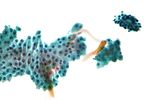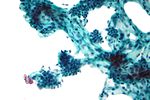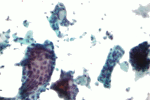Difference between revisions of "Breast cytopathology"
Jump to navigation
Jump to search
(→Breast cytopathology in a table: images) |
|||
| Line 54: | Line 54: | ||
| May have flat sheets of cells | | May have flat sheets of cells | ||
| Oncocytic change (apocrine change) common, histocytes (foamy cytoplasm), [[nucleoli]], large NCR | | Oncocytic change (apocrine change) common, histocytes (foamy cytoplasm), [[nucleoli]], large NCR | ||
| [ | | [[Image:Fibrocystic_changes_of_breast_-_cytology_1.jpg |thumb|150px | Oncocytes in FCC. (WC)]] | ||
|- | |- | ||
| Papillary neoplasm | | Papillary neoplasm | ||
| Line 60: | Line 60: | ||
| Sheets, usu. flat? | | Sheets, usu. flat? | ||
| Variable size, nucleolus | | Variable size, nucleolus | ||
| [ | | [[Image:Breast_papillary_neoplasm_1.jpg|thumb|150px| Papillary neoplasm. (WC)]] | ||
|- | |- | ||
| Ductal carcinoma | | Ductal carcinoma | ||
| Line 66: | Line 66: | ||
| '''3-D clusters''' | | '''3-D clusters''' | ||
| Nuclear size variation, '''membrane irreg.''', nucleoli (prominent) - every cell, cell size var. | | Nuclear size variation, '''membrane irreg.''', nucleoli (prominent) - every cell, cell size var. | ||
| [ | | [[Image:Ductal_carcinoma_-_cytology.gif |thumb|150px| Ductal carcinoma. (WC)]] | ||
|} | |} | ||
Revision as of 00:09, 26 December 2014
Breast cytopathology, also breast cytology, is a relatively small part of cytopathology, as core biopsies are more in style.
This article deals only with breast cytopathology. An introduction to cytopathology is in the cytopathology article.
Overview
Common indications
- FNA done for a clinically benign lesion - unusual to find malignancy.
- FNA of a satellite lesion to assess extent of a presumed cancer; done together with a core biopsy of another site.
Pitfalls
False negative:
- Lobular carcinoma - often single cells (may be in "chains"/"single file"), slightly hypercellular, cells appear bland/normal cytologically (if not carefully examined).[1]
Malignancy - the short version
- If the cells are not dissociated... cancer is not likely.[2]
- If there are stripped bipolar nuclei (these represent normal stromal cell) - cannot call overt malignancy.[3]
Normal breast
Features:
- Sheets of flat cells.
- Usu. no nucleoli.
- Stripped bipolar (elliptical) nuclei.
- +/-Adipose tissue:
- Peripheral nucleus.
- One large vacuole.
Notes:
- Adipose tissue may represent a lipoma.
Breast cytopathology in a table
The common entities in breast cytopathology and their features:
| Entity | Key feature | Architecture | Cells | Images |
|---|---|---|---|---|
| Normal | Flat sheets of cells, stripped bipolar nuclei | Flat sheets | Uniform size, lack nucleolus | |
| Fibroepithelial lesion (fibroadenoma, phyllodes) | Clusters of cells with staghorn shape (jagged edge), bare bipolar nuclei | Flat sheets & fluffy paucicellular (fibrous) tissue | Mixed pop. in cluster; nuclei: oval/spindle (myoepi.) and round (epi.). | Fibroadenoma - FNA (WC), Fibroadenoma FNA - Diff-Quik (WC), Fibroadenoma (flickr.com) |
| Fibrocystic change | Macrophages | May have flat sheets of cells | Oncocytic change (apocrine change) common, histocytes (foamy cytoplasm), nucleoli, large NCR | |
| Papillary neoplasm | Stalks (fibrovascular cores) | Sheets, usu. flat? | Variable size, nucleolus | |
| Ductal carcinoma | Nuclear atypia, lack of stripped bipolar nuclei | 3-D clusters | Nuclear size variation, membrane irreg., nucleoli (prominent) - every cell, cell size var. |
Diagnoses
Fat necrosis of the breast
General
Etiology - various:[4]
- Trauma.
- Surgery.
- Radiation.
Cytology
Features:[4]
- Dying/dead adipocytes:
- Light pink "low density" whispy poorly demarcated blobs - lack a nucleus.
- Early: cellular outlines seen, light pink/loose cytoplasm.
- Mid: cellular outlines indistinct, dense pink cytoplasm.
- Foamy macrophages - adjacent to fat.
- Abundant cytoplasm with granular (pink) crap inside.
- Oval nucleus with small nucleolus.
- Foamy macrophages - adjacent to fat.
- Late:
- Macrophages: multinucleated giant-cells.
- Calcification.
- Light pink "low density" whispy poorly demarcated blobs - lack a nucleus.
- +/-Myospherulosis - granulomatous reaction of fat & blood.
- Round aggregate of RBCs ~10-20 RBCs in diameter.
Notes:
- Healthy adipocytes - large cells, clear cytoplasm.
- Myospherulosis - due to exposure to fat, may be seen in the context of malignancy.[5]
Images:
- Early fat necrosis (ajronline.org).
- Mid fat necrosis (ajronline.org).
- Late fat necrosis (ajronline.org).
- Late fat necrosis - calcifications (ajronline.org).
Ductal carcinoma
- By convention one usually calls everything ductal carcinoma. It is the same as mammary carcinoma.
Cytology
Features:
- Classic five:[6]
- Cellular size variation.
- Nuclear size variation.
- May be marked adjacent cells different by factor of 2.
- Typically not marked - often ~1.5.
- Nucleoli.
- Should be in every cell.
- Multiple suggestive of malignant.
- Irregular chromatin pattern.
- Lack of singular bipolar nuclei (in the background), key negative.
- Other features:
- 3-D clusters - strong indicator.
- Cytoplasmic vacuoles - considered a classic finding.
Notes:
- Typically single cells present.[7]
- Exceptions are tubular carcinoma and colloid carcinoma; these have cells found in clusters or tubules/glands.[1]
- Intracytoplasmic "lumens"/inclusions (think lobular carcinoma).
- A useful rule of thumb: strongly suggestive of malignant ~3x RBC diameter & dyscohesive.[8]
DDx:
Images
Lobular carcinoma
Main article: Invasive lobular carcinoma
Cytology
Features:
- Discohesive, small, plasmacytoid cells.
- Targetoid mucin - key features.
Tubular carcinoma
Main article: Tubular carcinoma of the breast
Cytology
Features:
- Tubular structure with sharp point - key feature.
Mucinous carcinoma
Main article: Mucinous carcinoma of the breast
Cytology
Features:
- Mucin - blue/gray acellular material.
- Nuclear atypia.
DDx:
- Mucocele.
Fibroadenoma
Main article: Fibroadenoma
General
- Pitfall #1 for a malignant diagnosis, i.e. ductal carcinoma.
Cytology
Features:[9]
- Flat sheets of cells with finger-link projections (called "antler horns") with a mixed cell population:
- Cells with round nuclei (epithelium).
- Cells with oval nuclei (myoepithelium).
- Stromal fragments:
- Spindle cells.
- Fluffy appearance - relatively paucicellular.
- Naked bipolar nuclei.
- Represent myoepithelial cells stripped of their cytoplasm.
- Nuclei typically ovoid, may be spindle-shaped.
- Represent myoepithelial cells stripped of their cytoplasm.
Images:
Apocrine metaplasia/fibrocystic changes
Main article: Fibrocystic changes
Cytology
Features:[10]
- Architecture - pretty much anything (flat, single, papillary, clusters, sheets).
- Oncocytic change:
- Finely granular cytoplasm - key feature.
- Well-defined cell borders.
- Nuclei round typically with one nucleolus (occasionally several nucleoli).
- Macrophages (foamy) - key feature.
- Vacuolated cytoplasm + round/oval nuclei.
Image
Paget's disease
Main article: Paget disease of the breast
Cytology
Features:[10]
- Usually large cells with:
- Nuclear atypia and nucleolus.
- Abundant bubby (vacuolated) cytoplasm.
- Malignant cell may have "cell-in-cell" arrangement.
Papillary neoplasm
General
- Location: retroareolar.
Cytology
Features:[11]
- Fibrovascular core - may not be evident.
- Cohesive cell clusters.
- +/-Single cells with cytoplasm.
DDx:
- Fibroadenoma - has single cells without cytoplasm.
Image:
Apocrine metaplasia
Cytology
Features:
- Nucleoli.
- Granular cytoplasm.
Image:
Lactational changes
Main article: Lactational changes
General
- May mimic ductal carcinoma.
Cytology
Features:
- Nucleoli.
- Cytoplasmic vacuolization.
- Myoepithelial cells (bipolar cells) - important.
Notes:
- May for 3-D structures.
DDx:
- Ductal carcinoma.
See also
References
- ↑ 1.0 1.1 Lefkowitch, Jay H. (2006). Anatomic Pathology Board Review (1st ed.). Saunders. pp. 678. ISBN 978-1416025887.
- ↑ SM. 12 January 2010.
- ↑ SB. 27 January 2010.
- ↑ 4.0 4.1 Taboada, JL.; Stephens, TW.; Krishnamurthy, S.; Brandt, KR.; Whitman, GJ. (Mar 2009). "The many faces of fat necrosis in the breast.". AJR Am J Roentgenol 192 (3): 815-25. doi:10.2214/AJR.08.1250. PMID 19234281.
- ↑ Chau, KY.; Pretorius, JM.; Stewart, AW. (Oct 2000). "Myospherulosis in renal cell carcinoma.". Arch Pathol Lab Med 124 (10): 1476-9. doi:10.1043/0003-9985(2000)1241476:MIRCC2.0.CO;2. PMID 11035579.
- ↑ Sidawy, Mark K.; Ali, Syed Z. (2007). Fine Needle Aspiration Cytology: A Volume in Foundations in Diagnostic Pathology (1st ed.). Churchill Livingstone. pp. 137. ISBN 978-0443067310.
- ↑ Lefkowitch, Jay H. (2006). Anatomic Pathology Board Review (1st ed.). Saunders. pp. 678 (Q16). ISBN 978-1416025887.
- ↑ Chan, S. 26 April 2012.
- ↑ Lefkowitch, Jay H. (2006). Anatomic Pathology Board Review (1st ed.). Saunders. pp. 676. ISBN 978-1416025887.
- ↑ 10.0 10.1 Lefkowitch, Jay H. (2006). Anatomic Pathology Board Review (1st ed.). Saunders. pp. 677. ISBN 978-1416025887.
- ↑ URL: http://moon.ouhsc.edu/kfung/jty1/CytoLearn/CytoQuiz/CQ-021-040/CQ-035-M.htm. Accessed on: 9 April 2012.
- ↑ URL: http://www.womenshealthsection.com/content/print.php3?title=gynpc004&cat=60&lng=english. Accessed on: 31 March 2012.








